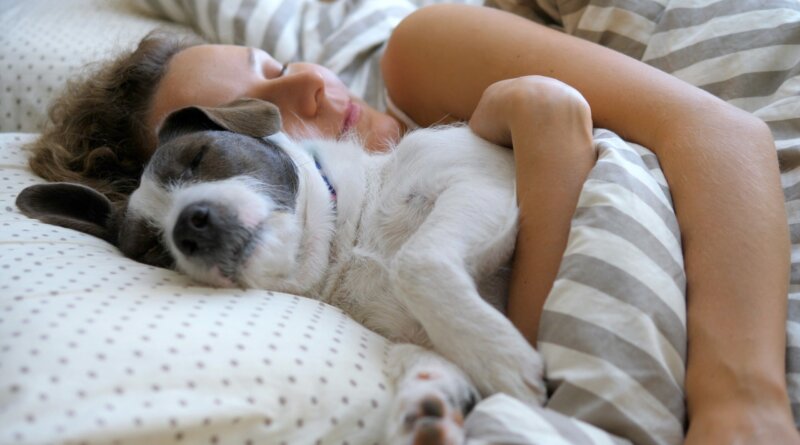Statistics and Should You Do It?
How many dog owners have their dog sleeping in bed with them?
A few months ago, a survey of 23,000 pet owners was conducted. There were some curious facts. A quarter of them acknowledged treating their pet as if they were small children.
A little less than 75% acknowledged keeping photos of them. But perhaps most strikingly, half owners sleep with their dogs. Not since the potato omelet has there been such a sociological divide.
So, we wondered what science had to say about sleeping with your dog.
Do People Really Sleep With Their Pets?
Sleep researchers have not paid much attention to this subject.
We have a lot of pseudo-theories about ‘dominance’ or ‘doggy soul’ that enjoy a lot of success on reality TV.
Research on ‘human-animal co-sleeping’ is a relatively neglected area.
As we have discussed elsewhere, sleep is more of a cultural phenomenon than it appears. It changes greatly by region and culture.
Only recently, Western societies separated sleeping space by age (children and adults). And it is only recently that the spaces between humans and animals have been completely separated.
There are many cultures in which such cohabitation practices are natural.
Most studies agree with the survey that there is a 50-50 split in co-sleeping with dogs and cats – the most common nighttime companions.
“… the research is insistent: about 50% of dog and cat owners sleep with their animal companions.”
Attachment to Our Pets
In this respect, the survey results are not surprising either.
The research argues that humans continue to show a strong attachment to their pets and are often considered important family members.
As Smith says, this is not gratuitous: animals are a source of support, affection, comfort, security and stability that can have important health benefits.
The size of the pet, indeed, has a lot to do with this.
If we look in more detail (for example, in dogs) we see that 76.85% of Yorkshire Terriers or 62.96% of Chihuahuas sleep with their owners compared to 18.18% of St. Bernards or 30.27% of Labradors.
Even so, the percentage of St. Bernards is a very high percentage.
In addition to what researchers already pointed out, other factors that intervene are the number of children in the family (more likely where there are no children) or gender (more likely with females).
Do You Get Equal Rest?
According to a recent small study conducted by experts at the Mayo Clinic, those who don’t want to let man’s best friends climb into bed may be right, and apparently, it’s not the best idea for them to sleep in the same room either.
The team of researchers – made up of pulmonologists, psychologists, and statisticians – analyzed the habits of 40 healthy adults without sleep disorders who were in the habit of having their dogs sleep in bed with them or somewhere in the bedroom.
The evaluation period lasted five months, and in one of the weeks both they and their dogs had to wear devices to monitor their sleeping habits.
The results showed that sleeping with dogs, whether in bed or just in the room, worsened people’s sleep and caused many to wake up several times during the night.
One of the things that were most affected was the posture in which the dog slept.
Your Dog Sleeping In Bed With You Vs In The Room
Although the quality of sleep turned out to be lower than that of a person who does not sleep with animals in the room, the data is neither alarming nor a reason to expel our pets from the bed.
The results explain that people who slept with dogs in bed achieved 80% sleep efficiency, and those who slept with animals in the bedroom 83%.
According to the experts, normal efficiency is between 85 and 89%, and once it exceeds 90%, we would be talking about very efficient sleep.
Another earlier survey, also conducted by the Mayo Clinic, already pointed to this problem.
In 2002 the director of the Mayo Clinic’s Sleep Disorders Center, John Shepard, published the results of a questionnaire carried out on 152 patients who had animals and who allowed them to sleep in their beds.
Half of them reported that their pets woke them up every night, and 21% of dog owners and 7% of people with cats complained that their pets snored.
Similar data comes from Australia.
Research carried out by CQ University concluded that people who sleep with animals take longer to fall asleep than those who do not allow them to sleep in the bed.
They also point out that the noises of dogs barking or snoring disturb the hours of rest of their owners.
However, there were no major differences in the number of times people who let their animals sleep in their beds versus those who did not, nor in the hours of sleep or how tired they were the next day.
In case of respiratory diseases…
Beyond the quality of sleep, some experts say that the main problem comes when owners have some allergy or respiratory problem: “People with allergies to animals or asthma should not sleep with their pets or allow them in the bedroom,” Dr. Derek Damin tells WebMD.
“If you’re not allergic, there’s really no problem with letting the dog sleep in the bed,” adds the expert, although he qualifies that in case it disturbs sleeping hours we should not let them sleep with us.
Increased Safety
For some people, as the director of North Shore Sleep Medicine in Chicago, Lisa Shives, explains, it can even be beneficial: “Some people feel safer and calmer when their pet sleeps with them”.
Recommendations
Experts from the Centers for Disease Control and Prevention remind us of the importance of keeping pets healthy. This involves taking them to the veterinarian regularly, vaccinating them and deworming them.
When we keep pets clean and healthy, it’s extremely rare, they can spread diseases.
In short, the possible harm that sleeping with a pet may cause us is not really that serious.
The harm comes when we have a disease that contraindicates it or the animal does not receive the care it needs.
Some Problems of Sharing Bedding With Pets
Research suggests that there are some possible problems in sharing bedding with animals.
Health risks
These include some immune responses, allergies, asthma, or hypersensitivity pneumonitis.
Bites and scratches can also occur through which infectious diseases associated with pets can be contracted.
Those most susceptible to such problems are young children, pregnant women, and immunodeficient patients.
However, the overall health risks are very low.
Almost negligible if animals receive medical care and maintain proper hygiene.
Sleeping problems
In general, the main problems related to sleep quality involve companions kicking, snoring.
This is true when children sleep in your bed, but pets also play an important role.
Without going any further, a Mayo Clinic study found that pet owners that sleep with their dogs tend to have sleep problems.
However, no issues were found when the dog slept in the bedroom with its owner.
It is difficult to know the real impact of these interruptions because they are very short interruptions.
The interruptions may be related to temperature mismatches between humans and pets; as well as differences in sleep-wake cycles.
Behavioral problems in animals
There have been studies that found when dogs are allowed to sleep with their owners, they may experience increased aggression and separation-related problems.
Effect on interpersonal relationships.
Finally, animals can be an important source of conflict and stress in couple relationships. They can generate intimacy problems.
A Dog Sleeping In Bed With The Owner: Breaking Down the Numbers
In Spain, 14% of dog owners sleep with their dogs in the same bed, a percentage that rises to 33 percent in the case of cats, which has the lowest figure of the other countries analyzed in the study ‘Pets and the home’.
This study was conducted by Houzz (a platform for home renovations) and notes that in the United States 41% of respondents sleep with their dogs.
The study also points out that in Spain 82 percent of pet owners are “happier” thanks to their pets. 76 percent have created a special corner in the home for their dog or cat.
In addition, it points out that “in the majority” of Spanish homes the owners cede a large part of the control of the home to their pets.
Even more, that 11 percent of the cats are in charge at home, compared to 3 percent of the dogs.
However, 40 percent of cat owners and 30 percent of dog owners admit that control of the home is shared.
Cats and dogs
There was a study, which involved more than 10,000 people worldwide. 550 of them Spanish, concluded that cats, in addition to taking control of the home, have “much more freedom” to climb on the furniture.
Specifically, in Spain, 36 percent of cats roam freely on the furniture in their homes. This is compared to only 23 percent of dogs. In the United States, this rises to 78 percent of cats with free access to furniture. And increases to 48 percent in the case of dogs.
Another of the conclusions is that the company of a pet is beneficial for both children and adults.
The most cited benefits are the happiness it brings to the individual (82%) and to the family (65%), as well as the helping to reduce stressful situations (50%).
Creating a special space
Regarding their own spaces for pets, 76 percent of the participants in the study affirmed having created a special corner in the house for their dog or cat, such as an area for eating, 68 percent; a bed or a special bench for them, 59 percent; and a corner in the house where they can rest or have fun, 55 percent.
Moreover, 28 percent of cat and dog owners have made home improvements to facilitate coexistence between individuals and pets in the last two years.
For example, 35 percent distributed some space; 26 percent improved or painted the walls and 25 percent created integrated areas in the house for their pets.
In this case, it is Australian and Italian Houzz users who are the most active in making home renovations to accommodate their pets, with 43 percent responding favorably. At the opposite end of the spectrum are French users with 27%.
As for the negative aspects, 76 percent of owners consider the biggest drawback to be the hair they shed; 36 percent believe the worst is the odors and 30 percent, the traces of dirt.
Smith and his research team found that sleeping with pets in bed had little impact on sleep quality in the time it took to fall asleep or the feeling of tiredness upon awakening.
Nevertheless, the authors argue that the continued practice of co-sleeping with pets indicates benefits of social support, social interaction, and personal safety, despite the disadvantages.
Frequently Asked Questions (FAQs)
Do most dog owners sleep with their dogs?
It’s not uncommon in this country to sleep with pets. In the American Pet Products Association, almost half of owners sleep with their dog in the bed.
In the survey, 62% of small dogs, 41% of small and 32% of large dogs sleep with their owners.
Is it unhealthy to sleep with your dog?
It is true that there are some health issues about your dog’s co-sleep. For example, human allergies may be exacerbated.
There is also a chance of disease transmission, from the dog to the human to the dog. This is rare, however.
Is it sanitary for a dog to sleep in your bed?
It’s really safe to sleep with their dog. Studies show from ninety to 95% of the time.
Although many veterans let their dogs sleep on their bed, a small proportion of people would not benefit from being with their dog this close.
Why do dogs sleep at the end of the bed?
Because of your leadership position, your dog knows that you have the best comfort spot.
They still love you and want to be around you, so that they hang around your place of comfort.
Many time owners that sleep with their dogs find that their dog will sleep directly next to them or at the end of the bed.
Final Thoughts
Overall, it seems that science agrees with common sense. Owners that sleep with their dog may have some problems, but they are always related to previous health and behavioral problems.
On the other hand, if our pet is healthy, has a proper hygiene and a ‘good education’ not only there are no problems, but it can have very positive effects.
Related











